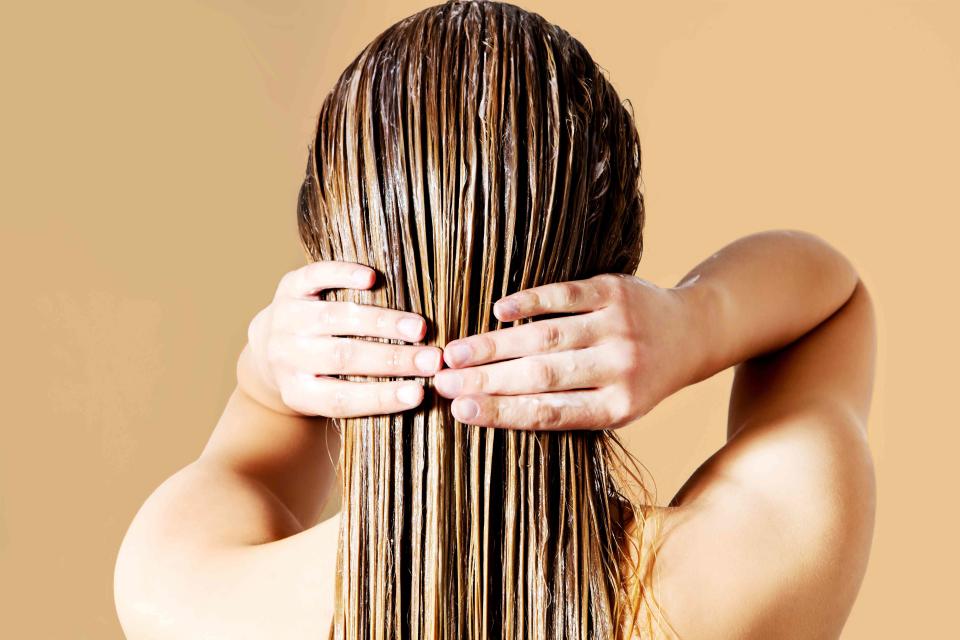Yes, Overconditioning Hair Can Be a Bad Thing
Here’s how to tell if you’re overdoing it.

Piotr Marcinski/Getty Images
Shampoo and conditioner—the two go together like peanut butter and jelly. Sure, you could use one and not the other, but why would you when the dynamic duo is just meant to be paired? Even if your haircare routine is otherwise non-existent, it’s likely that this combo exists in your shower. And for good reason: Shampoo is designed to lift away dirt and oil and clean your hair, while conditioner detangles, softens, and adds shine and sleekness, explains celebrity hairstylist Tom Smith, International Colour Creative Director at evo hair. It does so through the use of moisturizing or conditioning ingredients (not all of which are created equal, but more on that in a moment), and because conditioners have a lower pH, around 4.5-5. Whereas higher pH products open the cuticle, the outermost layer of the hair, conditioners’ lower pH closes the cuticle, increasing shine and smoothness, Smith explains.
Shinier, smoother, softer strands? Yes, please. If a little conditioner can do all of that, then using lots of conditioner must make things even better, right? Eh, not quite. It’s not necessarily that you need to use conditioner sparingly, but rather that it’s important to find the right type and use it as is appropriate for your particular hair type and texture. Because, yes, overconditioning is a very real thing, and can end up having the opposite of the intended effect. Here’s what you need to know.
What Happens When You Use Too Much Conditioner
Simply put, either too much conditioning and/or the use of conditioning agents that are too heavy leads to build up on your hair over time, causing lankness and flatness, Smith explains. While it can happen to anyone, those with finer or non-porous hair types are more likely to experience it—as well as experience it to a greater degree. Finer hair types are more prone to easily being weighed down. Non-porous hair types (meaning the cuticle is closed tightly, this typically is seen more often in straight hair) can’t absorb the conditioning ingredients. “They get weighed down by them because they’re sitting on the surface of the hair,” Smith points out.
How to Tell If You’ve Overconditioned
All of those aforementioned things are telltale signs, i.e. if your hair is flat, limp, or always feels heavy and weighed down. If you feel like it’s getting greasy more quickly or your styles aren’t holding as well, those are also red flags, according to Smith. If that’s the case, he suggests using a deep cleansing or clarifying shampoo a few times in a row to help remove buildup and get your hair back to its baseline state.
How to Use Conditioner
As a general rule of thumb, it’s totally fine to, and you really should, condition your hair after every wash. That being said, “It shouldn’t be left on for longer than the instructions advise and always make sure to rinse it out thoroughly,” Smith advises. If you also have a deep conditioner or conditioning mask that’s part of your haircare routine, that should be used once a week, max, adds Annalise Kalamatas, a stylist at Tricoci Salon & Spa.
How you apply it matters, too. Unlike shampoo, “conditioner isn’t intended for the scalp and is meant to be used only on the hair. Apply it just from mid-shaft to ends in order to reduce oily or weighed down roots,” says Kalamatas. And make sure you’re not using too much; fine hair needs about a dime-size amount of conditioner, while thicker hair textures require about a golf ball size dollop, she adds. In related news…
Most importantly, pick the right type of conditioner for your hair type. According to Smith, avoiding paraffin wax and mineral oil across the board is the move, as these ingredients are too heavy for all hair types. If you have fine or thin strands, seek out amino acids, peptides, and glycerin, all ingredients that hydrate and condition but are lightweight enough that they won’t weigh down your hair, Kalamatas notes. Have a thick, coarse, or frizzy texture? Heavier options—oils such as argan or coconut and aloe vera—are best for you.“ Using the appropriate product will give you the nutrients your hair needs without the risk of losing volume or bounce,” she says.
For more Real Simple news, make sure to sign up for our newsletter!
Read the original article on Real Simple.

